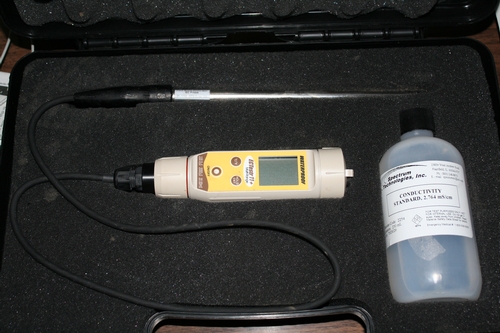Just had a great conversation with Mike Cahn, our Irrigation and Water Resources Advisor in Monterey County regarding the salt issues in the berry fields on the Central Coast.
The Basics of Salinity Measurement: Electrical conductivity (EC) is a measure of the combined effect of all the salts in the soil or irrigation water. Generally in irrigation water an EC of less than 1.5 dS/m is not known to present problems for growing strawberries. Strawberries can often tolerate water of EC above 1.5 if the main salts are calcium and sulfate. Soil EC thresholds for strawberry were based on a saturated paste extract from the soil. A soil paste extract with an EC of 2 or 3 shouldn’t be seen as a big issue for strawberries. Directly measuring soil EC with a probe (see the example in the photo below) will often produce much higher numbers than would be found from a saturated pasted extract because the salts are concentrated in less soil moisture.
There are different types of salt, and some are more harmful than others to the roots of the plant. One way of gauging how great the potential of harm a certain species of salt presents to the plant is how easily it precipitates out of solution – salts which stay in solution easily will tend to get taken up by the plant root when it pulls up the water while those which precipitate out are solid and not capable of being taken up by the plant root.
So, take for example calcium carbonate and calcium sulfate, which are both salts and matter of fact compose most of that white stuff we are seeing on the surface of the soil around here. This white stuff is a precipitate and as a solid won’t be taken up and no longer presents a danger to the plant root. Sodium and chloride on the other hand, stay in solution much more easily and therefore can also be taken up by the plant root. Moreover, since sodium and chloride continue to stay in solution even as water is evaporating away, their concentration rises and they become even more harmful to the plant roots and the plant itself.
Managing Sodium and Chloride: Fortunately, it’s pretty easy to leach away sodium and chloride from around the plant roots. One just needs to add more water to the soil than what is necessary for the plant. Since for example strawberry plants planted in autumn of 2013 are still quite small and the weather has been very cool (meaning low evapotranspiration), Mike estimates probably about a half to 1 inch is all they needed in the last month of December. Any water applied in excess of this amount will leaching away and carrying whatever salt is in solution .
Possible Salt Accumulation from Fertilizers: Since it would seem that harmful levels of sodium and chloride are being leached away by current irrigation practices, Michael and I focused our conversation on the possibility of nitrates from fertilizer – especially the pre-plants- being a major source of the salt damage that we are currently experiencing in our area. Because preplant N is applied in bands near the roots of the transplants and there is little uptake of N at this early stage of growth, nitrate released from the fertilizer may be increasing the salinity near the roots. We calculated that if 90 lbs of N/acre released from 2 bands of fertilizer on 52 inch wide beds, the salinity may increase in the root zone by 3.4 dS/m. During a typical year about 12 inches of rainfall will occur between December and March. During a drought year, it is possible that the irrigation water applied is of sufficient volume to activate the pre-plant fertilizer but not enough to wash it away and so there is a consequent buildup of harmful nitrate (a salt) right around the root ball.
This will be worth looking into in the very near future.
Attached Images:
